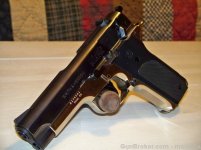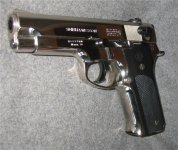Judge Colt, so if I'm understanding you correctly, the extractor on the model 39 is more prone to failure? Also if anyone can tell me, being new to guns with a decocker, how can the 59 have an accidental discharge if dropped, like I've heard? Is that just if the hammer is cocked? Not if it's decocked, right? Because the hammer would be blocked then. Thanks fellas.
I see that your questions have already been addressed, but some clarification is needed.
As stated, an inertia firing pin can develop enough energy if dropped on the muzzle "just right" to ignite the primer. The M39/M59 firing pin is prevented from moving if the safety is engaged, but not if the safety is not engaged. The firing pin safety on Second Generation and later guns prevents movement of the firing pin until the trigger is pulled.
There is a nomenclature issue here that illustrates how important it is to be accurate in nomenclature. The Model 39 and the Model 39-2 do not use the same style of extractor. The Model 39 has the long extractor, which is more prone to breakage than the short extractor found on the Model 39-2. While sometimes a general reference to a "Model 39" is sufficient, it is not when discussing changes that resulted in a new model number being assigned.
The Model 39 and the early Model 39-2 both used a two-piece barrel bushing. The "flat part" sitting vertically against the front end of the slide is a stamped, separate piece from the cylinder-like portion of the bushing that goes around the barrel. The two are attached together by "rolling" the front edge of the cylindrical part into the hole in the flat part. Some (most?) of those two-piece bushings separate, allowing the recoil spring to escape, which puts the gun out of service. (The early Model 59 used the same two-piece bushing with the same problem.)
The "fix" is the cast one-piece barrel bushing, which can easily be identified by the lack of a hole at the bottom for the recoil spring guide rod. I do not believe eliminating the hole had nothing to do with "binding" on the guide rod. There just is no need for the hole in the cast part, so it was eliminated. (The half-round configuration "straddling" the guide rod is sufficient to keep the bushing from turning, which was the purpose of the hole in the original stamped two-piece part.) No "dash-number" change was made when the one-piece bushing was introduced on either the Model 39-2 or Model 59.
There was never any "Model 59-2." The nomenclature was "Model 59" throughout production. The Model 39-2 nomenclature was solely to identify the change in the extractor style. As stated, the change to the one-piece barrel bushing did not result in a new "dash number" for either the Model 39 or the Model 59.


